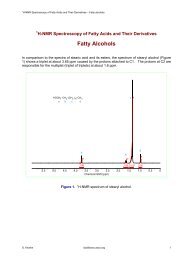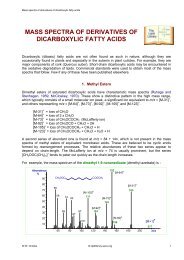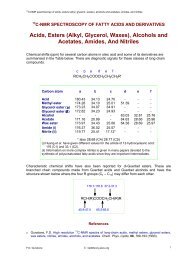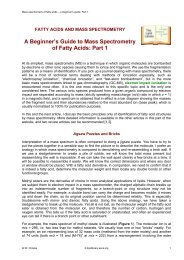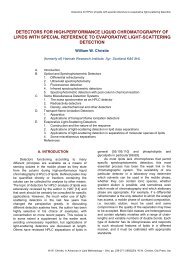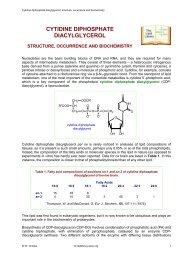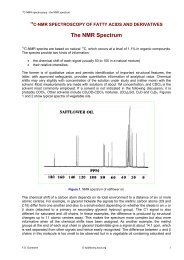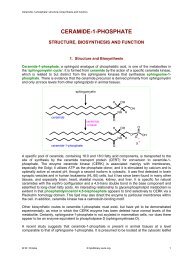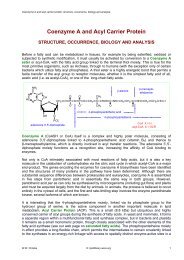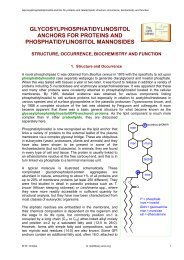Esterification of fatty acids - Lipid Library - American Oil Chemists ...
Esterification of fatty acids - Lipid Library - American Oil Chemists ...
Esterification of fatty acids - Lipid Library - American Oil Chemists ...
Create successful ePaper yourself
Turn your PDF publications into a flip-book with our unique Google optimized e-Paper software.
Preparation <strong>of</strong> ester derivatives <strong>of</strong> <strong>fatty</strong> <strong>acids</strong> for chromatographic analysis<br />
Scheme 17. Reaction <strong>of</strong> <strong>fatty</strong> <strong>acids</strong> with a Grignard reagent, ethyl magnesium bromide (26).<br />
first used to convert the <strong>fatty</strong> acid components <strong>of</strong> the<br />
wax esters from jojoba oil to tertiary alcohols, the<br />
primary alcohols being released as such [282]. The<br />
two groups <strong>of</strong> compounds could be analysed<br />
simultaneously by GC in this form. More recently, it<br />
has been shown that the reaction can be used with a<br />
variety <strong>of</strong> fats and oils, especially those containing<br />
short-chain <strong>fatty</strong> <strong>acids</strong> as in milk fat [281]. Different<br />
alkyl moieties were employed to give theoretical<br />
response factors for flame-ionization detection that<br />
were close to unity, even with butyric acid. Although<br />
the reaction products are very different from the<br />
esters that have traditionally been favoured for GC<br />
analysis, the methodology is simple and may have<br />
wide applicability; it might repay further study.<br />
I. SPECIAL CASES<br />
1. Short-chain <strong>fatty</strong> <strong>acids</strong><br />
a<br />
RCOOR' + 2CH3CH2MgBr R(CH3CH2) 2COH<br />
(26) (27) a<br />
Much attention has been given to the<br />
preparation and analysis <strong>of</strong> esters <strong>of</strong> short-chain <strong>fatty</strong><br />
<strong>acids</strong> by GC, largely because <strong>of</strong> their occurrence in<br />
milk fats. Reviews <strong>of</strong> the problems in such analyses<br />
have been published [53,158]. Short-chain <strong>fatty</strong> <strong>acids</strong>,<br />
in the free state or esterified to glycerol, can be<br />
converted completely to methyl esters by any <strong>of</strong> the<br />
reagents described above, but quantitative recovery<br />
from the reaction medium may not be achieved<br />
unless special precautions are taken. Losses can<br />
occur at several stages in any procedure. Short-chain<br />
<strong>fatty</strong> acid esters (methyl especially) are volatile and<br />
may be lost selectively on refluxing the esterification<br />
medium, they are more soluble in water than longerchain<br />
esters and can be lost in an aqueous extraction<br />
step, or they may be distilled <strong>of</strong>f when the extracting<br />
solvent is evaporated. Selective losses can also<br />
occur if non-saponifiable impurities have to be<br />
removed by sublimation or thin-layer chromatography<br />
(TLC) purification.<br />
Losses occurring during refluxing <strong>of</strong> solutions<br />
can be avoided by carrying out the reaction in a<br />
sealed vessel or using procedures that work<br />
satisfactorily at room temperature. Losses <strong>of</strong> shortchain<br />
esters during aqueous extractions can never be<br />
eliminated entirely but they can be kept to a minimum<br />
with care. Some <strong>of</strong> the factors involved were studied<br />
by Dill [78], who found that recoveries could be<br />
improved greatly by salting out the esters.<br />
Hydrocarbon solvents, such as hexane, pentane or<br />
light petroleum gave better recoveries than did diethyl<br />
ether or benzene. Others [174] obtained excellent<br />
recoveries <strong>of</strong> short-chain esters by extracting with a<br />
solvent mixture <strong>of</strong> docosane and petroleum ether, but<br />
the docosane could interfere with the subsequent GC<br />
analysis <strong>of</strong> the esters. Careful removal <strong>of</strong> excess<br />
solvents at low temperatures on a rotary film<br />
evaporator is better than using a stream <strong>of</strong> nitrogen<br />
and will keep losses <strong>of</strong> short-chain esters down, but<br />
these cannot be eliminated completely.<br />
The best esterification procedures for shortchain<br />
<strong>fatty</strong> <strong>acids</strong> are those in which heating <strong>of</strong> the<br />
reagents is avoided and in which stages involving<br />
aqueous extraction and solvent removal are absent.<br />
Many analysts, including the author, have found that<br />
the alkaline transesterification procedures <strong>of</strong><br />
Christopherson and Glass [59] and <strong>of</strong> Luddy et al.<br />
[217] are the most convenient and quantitative for<br />
obtaining short-chain methyl esters from lipids, as no<br />
aqueous extraction or solvent removal steps are<br />
necessary. In the latter procedure, the lipid sample<br />
was transesterified at 65°C with a small amount <strong>of</strong><br />
0.4M potassium methoxide in a sealed tube. On<br />
cooling, carbon disulfide was added and excess<br />
methanol was removed by adding anhydrous calcium<br />
chloride. An aliquot <strong>of</strong> the supernatant solution was<br />
injected directly into the gas chromatograph. If the<br />
sample contained a high proportion <strong>of</strong> free <strong>fatty</strong> <strong>acids</strong>,<br />
these were esterified with boron trifluoride in<br />
methanol after the transesterification reaction had<br />
been completed. In the method <strong>of</strong> Christopherson<br />
and Glass [59], the fat sample was dissolved in 19<br />
volumes <strong>of</strong> petroleum ether in a stoppered-tube and<br />
one volume <strong>of</strong> 2M sodium methoxide in methanol<br />
was added. Transesterification was complete in a few<br />
minutes at room temperature and an aliquot <strong>of</strong> the<br />
reaction mixture was again injected directly onto the<br />
GC column. If appreciable amounts <strong>of</strong> free <strong>fatty</strong> <strong>acids</strong><br />
were present in the sample, they could be methylated<br />
when the transesterification reaction was finished by<br />
adding 5 volumes <strong>of</strong> 10% hydrogen chloride in<br />
methanol and leaving the reaction mixture for a<br />
further hour at room temperature before injection<br />
onto a packed GC column.<br />
Injection <strong>of</strong> reaction media containing basic and<br />
acidic esterification catalysts directly onto GC<br />
columns shortens their working lives. The top few<br />
centimetres <strong>of</strong> packed columns can be replenished<br />
periodically, while lengths <strong>of</strong> deactivated tubing or<br />
"retention gaps" ahead <strong>of</strong> capillary columns will<br />
protect the latter. This can be a small price to pay for<br />
the speed, simplicity and accuracy <strong>of</strong> these<br />
procedures.<br />
W.W. Christie, in Advances in <strong>Lipid</strong> Methodology – Two, pp. 69-111 [1993] [Ed. W.W. Christie, <strong>Oil</strong>y Press, Dundee].



